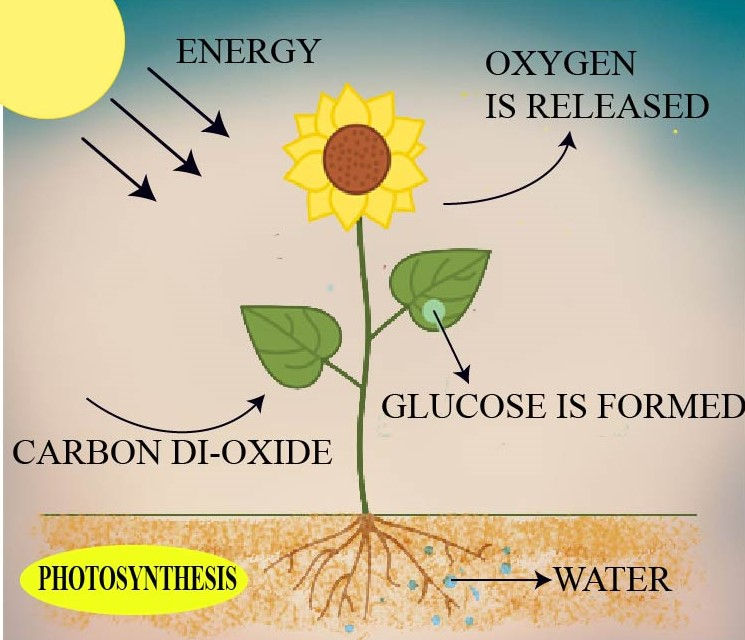
What is necessary for photosynthesis?
(a) Chlorophyll
(b) Sunlight
(c) Carbon dioxide and water
(d) All of the above
Answer
561.6k+ views
Hint: They are required for providing the source of minerals, carbon, UV radiation so as to produce starch (food in plants). They are essential for the process and are the processor for the production of food.
Complete answer:
Photosynthesis is the mechanism of food processing in the presence of sunlight. It has two steps: In the first stage, the chlorophyll traps light energy and transforms it into chemical energy and calls it the light reaction. Such chemical energy is used in the second stage to prepare food from water and carbon dioxide and is known as a dark reaction.

Photosynthesis is a mechanism used to transform light energy into chemical energy by plants and other species that can later be released to fuel the activities of the species. In carbohydrate molecules, such as sugars, which are synthesized from carbon dioxide and water, this chemical energy is stored. Oxygen is often published as a waste product in most circumstances. Photosynthesis is done by most plants, most algae, and cyanobacteria; photoautotrophs are called such species. Photosynthesis is primarily responsible for the creation and maintenance of the Earth's atmospheric oxygen content and provides much of the energy required for life on Earth.
Additional information:
Water, the primary component of the Earth's hydrosphere and the fluids of all known living organisms, is an inorganic, clear, tasteless, odorless, and virtually colorless chemical material.
Sunlight, especially infrared, visible, and ultraviolet light, is a portion of the electromagnetic radiation produced by the Sun. Sunlight on Earth is scattered and filtered through the atmosphere of Earth and is apparent as daylight when the Sun is above the horizon.
Carbon dioxide is a chemical compound made up of one carbon and two atoms of oxygen. By its formula ${ CO }_{ 2 }$, it is sometimes referred to. At a low concentration, it is found in the Earth's atmosphere and functions as a greenhouse gas. It is called dry ice in its solid-state. It is a significant component of the cycle of carbon.
The green photosynthetic pigment present in plants, algae, and cyanobacteria is chlorophyll. Chlorophyll absorbs much of the electromagnetic spectrum in the blue and to a lesser degree in the red portions, hence its vivid green hue.
So, the correct answer is ‘All of the above’.
Note: Photosynthesis is the mechanism through which substances such as carbohydrates are made through plants and certain microorganisms. It is an endothermic (heat taking) chemical process that transforms carbon dioxide into sugars using sunlight. Sugars are used as energy by the cell and to make other kinds of molecules.
Complete answer:
Photosynthesis is the mechanism of food processing in the presence of sunlight. It has two steps: In the first stage, the chlorophyll traps light energy and transforms it into chemical energy and calls it the light reaction. Such chemical energy is used in the second stage to prepare food from water and carbon dioxide and is known as a dark reaction.

Photosynthesis is a mechanism used to transform light energy into chemical energy by plants and other species that can later be released to fuel the activities of the species. In carbohydrate molecules, such as sugars, which are synthesized from carbon dioxide and water, this chemical energy is stored. Oxygen is often published as a waste product in most circumstances. Photosynthesis is done by most plants, most algae, and cyanobacteria; photoautotrophs are called such species. Photosynthesis is primarily responsible for the creation and maintenance of the Earth's atmospheric oxygen content and provides much of the energy required for life on Earth.
Additional information:
Water, the primary component of the Earth's hydrosphere and the fluids of all known living organisms, is an inorganic, clear, tasteless, odorless, and virtually colorless chemical material.
Sunlight, especially infrared, visible, and ultraviolet light, is a portion of the electromagnetic radiation produced by the Sun. Sunlight on Earth is scattered and filtered through the atmosphere of Earth and is apparent as daylight when the Sun is above the horizon.
Carbon dioxide is a chemical compound made up of one carbon and two atoms of oxygen. By its formula ${ CO }_{ 2 }$, it is sometimes referred to. At a low concentration, it is found in the Earth's atmosphere and functions as a greenhouse gas. It is called dry ice in its solid-state. It is a significant component of the cycle of carbon.
The green photosynthetic pigment present in plants, algae, and cyanobacteria is chlorophyll. Chlorophyll absorbs much of the electromagnetic spectrum in the blue and to a lesser degree in the red portions, hence its vivid green hue.
So, the correct answer is ‘All of the above’.
Note: Photosynthesis is the mechanism through which substances such as carbohydrates are made through plants and certain microorganisms. It is an endothermic (heat taking) chemical process that transforms carbon dioxide into sugars using sunlight. Sugars are used as energy by the cell and to make other kinds of molecules.
Recently Updated Pages
The number of solutions in x in 02pi for which sqrt class 12 maths CBSE

Write any two methods of preparation of phenol Give class 12 chemistry CBSE

Differentiate between action potential and resting class 12 biology CBSE

Two plane mirrors arranged at right angles to each class 12 physics CBSE

Which of the following molecules is are chiral A I class 12 chemistry CBSE

Name different types of neurons and give one function class 12 biology CBSE

Trending doubts
One Metric ton is equal to kg A 10000 B 1000 C 100 class 11 physics CBSE

Explain zero factorial class 11 maths CBSE

What is 1s 2s 2p 3s 3p class 11 chemistry CBSE

Discuss the various forms of bacteria class 11 biology CBSE

State the laws of reflection of light

Difference Between Prokaryotic Cells and Eukaryotic Cells




